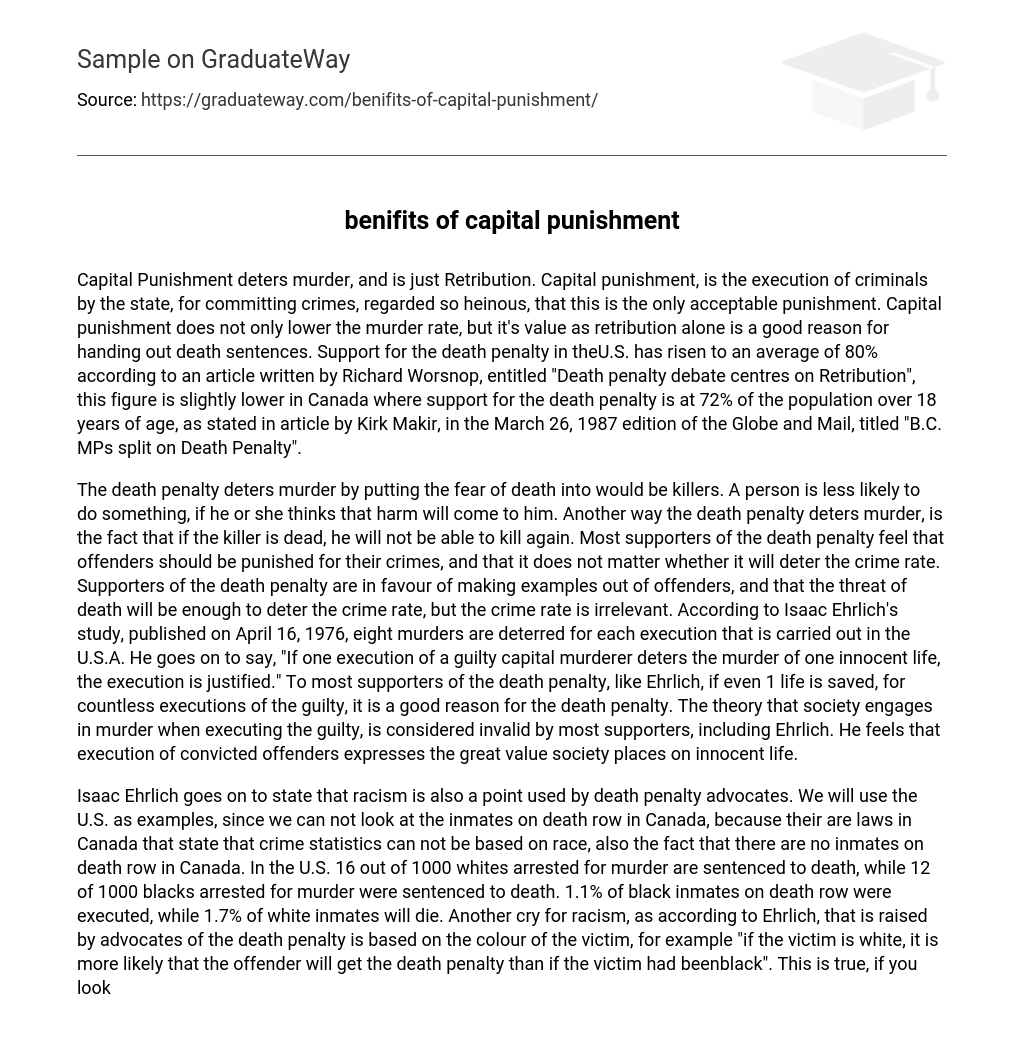Capital punishment, also known as the execution of criminals by the state for committing heinous crimes, serves as both a deterrent to murder and a form of retribution. It enjoys widespread support in the U.S., with an average of 80% of the population favoring it, according to Richard Worsnop’s article “Death penalty debate centres on Retribution.” In Canada, support for the death penalty is at 72% among individuals over 18 years old, as mentioned in Kirk Makir’s article titled “B.C. MPs split on Death Penalty” published in the March 26, 1987 edition of the Globe and Mail.
The fear instilled by the death penalty is believed to deter potential killers and reduce harmful actions. It also serves as a permanent prevention measure by stopping convicted murderers from committing further crimes. Many supporters of capital punishment prioritize punishment over its impact on overall crime rates, focusing on setting examples and using the fear of death to discourage criminal behavior. According to Isaac Ehrlich’s study conducted on April 16, 1976, each execution in the U.S.A. deters eight murders. Ehrlich even argues that if executing guilty capital murderers saves one innocent life for every execution, it justifies using the death penalty. Most proponents, like Ehrlich, reject the idea that executing criminals contributes to a culture of murder; instead, they see it as society’s way of valuing innocent lives.
According to Isaac Ehrlich, racism influences support for the death penalty. To illustrate this point, we will focus on the United States because Canada lacks race-based crime statistics and does not have any inmates on death row. In the US, out of 1000 white individuals arrested for murder, 16 are given the death penalty, while among every 1000 black individuals arrested for murder, 12 receive capital punishment. Ehrlich also highlights how racial bias is further emphasized by the color of the victim. For instance, if the victim is white, there is a higher likelihood of the offender facing capital punishment compared to if the victim was black. This disparity is backed by actual data showing more cases where those who murdered whites are sentenced to death compared to cases involving blacks. The reason behind this difference lies in both a larger number of white victims and a higher rate of apprehending their killers. However, it is crucial to examine proportionately cases involving black victims despite their significantly lower numbers.
Regarding the percentages, all races have similar numbers, indicating that racial disparity is not an issue. In 1986, Professor Stephen K. Layson from the University of North Carolina conducted a study reevaluating Ehrlich’s findings. This study determined that the deterrent effect of the death penalty was underestimated. Professor Layson found that each execution in the United States prevented 18 murders and increased the chances of apprehending, convicting, and executing violent criminals.
Support for capital punishment has grown as crime rates in America have risen, according to George C. Smith, Director of Litigation at the Washington Legal Foundation. In his statement titled “In Support of the Death Penalty,” Smith highlights this trend. In 1966, 42% of Americans favored capital punishment while 47% opposed it. However, by 1986 with an increase in crime rate, support had grown to 80%, opposition decreased to only 17%, and there were still 3% undecided voters who mostly leaned towards supporting it if forced to decide immediately.
Now let us redirect our attention to Canada.
The last two individuals to be executed in Canada were Arthur Lucas and Ron Turpin, who were hanged on December 11, 1962. The death penalty was abolished in Canada in the latter part of 1976 after a 98-hour debate, narrowly escaping defeat by only six votes. During the abolition debate in 1976, supporters of the death penalty threatened Members of Parliament and their families. Many MPs voted based on their personal beliefs rather than the wishes of their constituents.
Similarly, discussions about accepting the reinstatement of the death penalty by the federal government took place in British Columbia in 1987. Amongst the MPs, there was a split with 17 out of 29 supporting the death penalty. Despite public support for the death penalty being around 70% in British Columbia at that time, MPs believed it was their duty to vote according to their own convictions rather than for political gain.
In 1987, the Progressive Conservative government sought to hold a free vote on capital punishment reinstatement but faced opposition from Justice Minister Ray Hnatyshyn who exerted pressure on MPs to vote against the bill.It is widely believed that if not for Ray Hnatyshyn’s opposition,the reinstatement of capital punishment would have gone through,makingthe death penalty a reality today.
Both sides of the capital punishment debate are firmly entrenched in their beliefs and employ various tactics to convince others. However, evidence from studies conducted by Isaac Ehrlich in 1975 and Prof. Stephen K. Layson in 1986, along with recent polls in Canada and the United States, support our belief that capital punishment effectively deters crime. Furthermore, these studies and surveys suggest that both the public and society as a whole favor the death penalty. The threat of capital punishment influences potential offenders by making them contemplate whether committing a crime is worth risking their lives. Even if it fails to deter crime, the death penalty allows society to pursue justice and ensures that murderers will never pose a threat again.
.—Works Cited
From: Take Notice, (Copp Clarke Pitman Ltd., 1979) page 163
From: Article written by David Vienneau published in the March 24, 1987 edition of the “Toronto Star”, titled, Debate Agonizing for MPs.
From: Article written by Kirk Makir, published in March 26, 1987 edition of the “Globe and Mail”, titled, BC MPs Split on Death Penalty Debate.
From: Article written by Hugh Winsor, published in April 29, 1987 edition of the “Globe and Mail”, titled, Debate on Death Penalty placed on hold.





